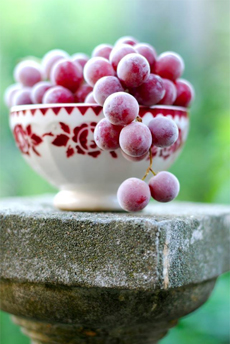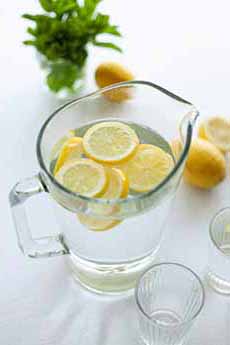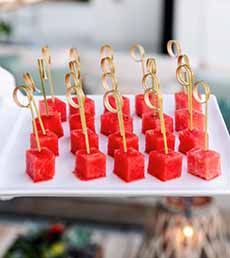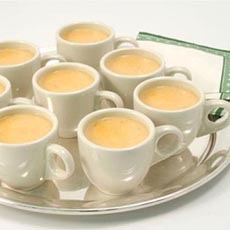Palate Cleanser: A Way To Refresh Your Taste Buds Between Courses
|
A palate cleanser is a serving of food or drink typically served between the fish and meat course at a formal dinner and at other food events, such as wine tastings. The palate, or roof of the mouth, works with the nose and tongue to determine what you taste. The purpose of the palate cleanser is to cleanse the mouth of the lingering flavors of the prior course, bite, or sip to enable the flavors of the next course to shine through. In essence, the palate cleanser “resets” the taste buds. A light palate cleanser also gives you a few moments to slow down the consumption of a progression of rich dishes. The concept originated in French fine dining, where a lemon sorbet was often served between the fish and the meat courses. A scoop of sorbet was presented in a footed glass dish or a Champagne sorbet glass (you can use another small wine glass—photo #1—or a juice glass). While we can’t find the precise origin of palate cleansing, it appears in 19th-century menus for sumptuous, multi-course French meals. Each region of France had its own specialty—usually a locally produced product such as a shot of Calvados (apple brandy), or a scoop of Calvados sorbet, in Normandy. Palate cleansers are also known as entremets*, Trou Normand (in Normandy [literally, “a Norman hole”]), Trou Bourguignon (in Burgundy [a Burgundian hole]), and remise en bouche. While intermezzo is Italian for palate cleanser, not all small dishes served between courses are palate cleansers. For example, an amuse-gueule (“it entertains [the] throat,” in French) or amuse-bouche (the same thing, with bouche being the word for mouth instead of gueule for throat) are creative nibble served before a meal to whet the appetite. These latter bites emerged as a mini course during the nouvelle cuisine movement, which emphasized smaller, more intensely flavored courses. They differ from hors d’oeuvres in that they are very small, usually just one or two bites, and offered free of charge. While sometimes the amuse-bouche could be a rather simple offering—such as a plate of olives or a ramekin of tapenade (remember the relish tray?), it often becomes a showcase of the artistry of the chef Per the famous chef Jean-Georges Vongerichten, “The amuse-bouche is the best way for a great chef to express his or her big ideas in small bites” [source]. A tart sorbet or granita is the most popular palate cleanser. A combination of cold, crisp, and sharp flavors, lightly sweetened, helps to dispel strong flavors or grease from the food most recently ingested. Apple, citrus flavors, and mint sorbet are the clear winners here. You can add a garnish of fresh basil, mint, or tarragon You can also make a sorbet with alcohol, like the aforementioned Calvados. Our wine editor makes his with grappa or marc†. Also on the list: For a casual gathering, cubes of watermelon with or without a mint leaf are a good bet (photo #4). If you have nothing else on hand, offer a sprig of mint or parsley to chew on. Most people come to prefer a specific palate cleanser that best works for them at a particular type of tasting. *Historically, an entremet was a palate cleanser. Today the term is used in France to indicate an individual dessert; specifically, a cake with layers prepared separately using individual molds or rings, then assembled to form the final dessert. Here are some delicious examples. †Marc, short for eau de vie de marc (its full name), also called pomace brandy, is distilled from what is left over after pressing the grapes used in wine production. The skins, pulp, seeds, and sometimes stems, are collectively called pomace. It can be aged briefly or for years. The result tastes like very strong whiskey. It is served as a digestif at the end of dinner, after the cheese and dessert. Some people have it with their espresso. You don’t pronounce the c at the end of the word. It is pronounced mahr, to rhyme with car. In Italian it is called grappa, bagaço in Portuguese, and orujo in Spanish. |
|
|
|
CHECK OUT WHAT’S HAPPENING ON OUR HOME PAGE, THENIBBLE.COM.
|
||







